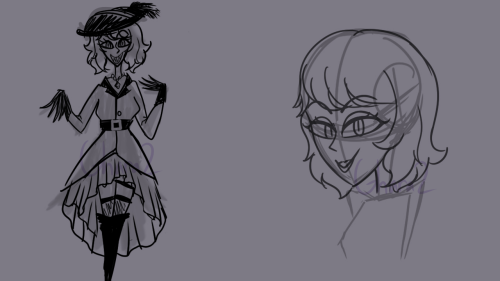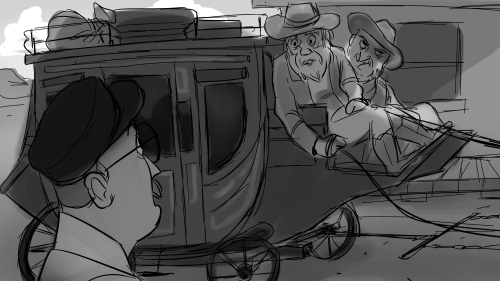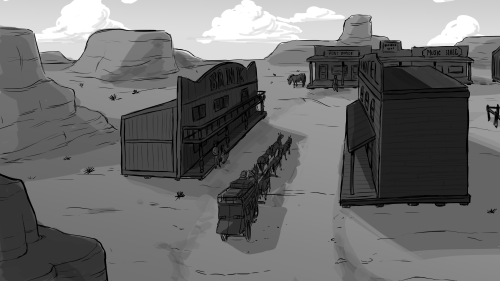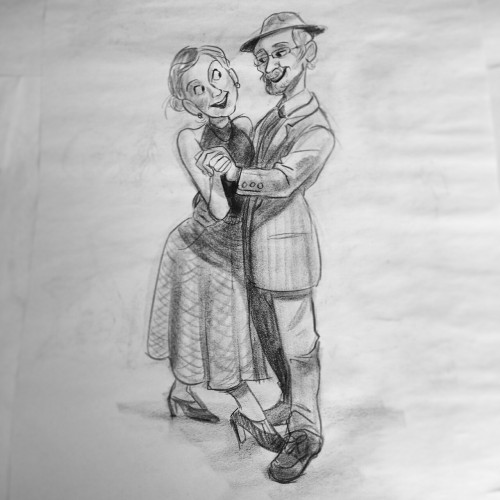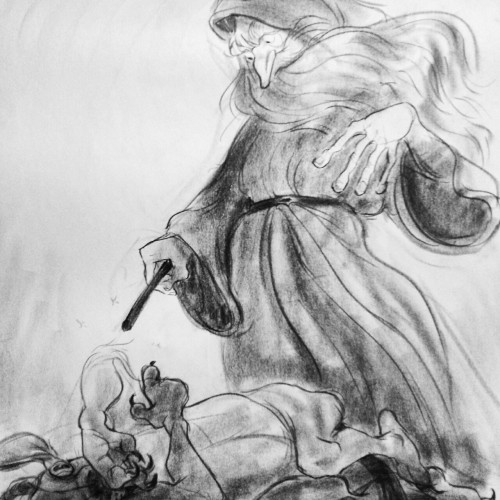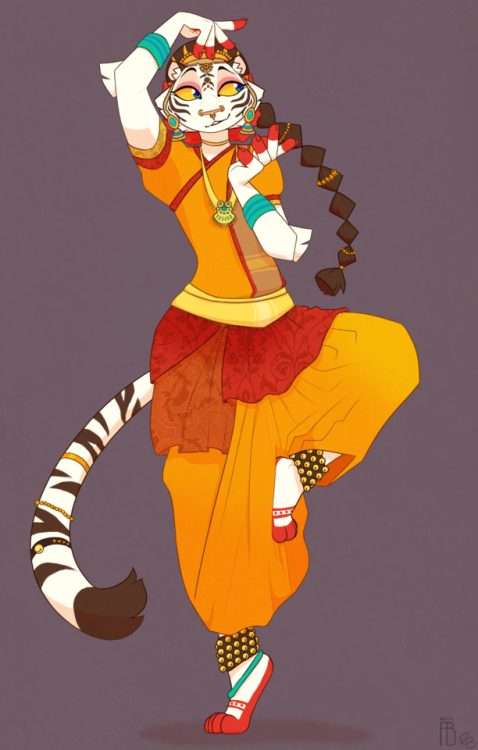#schoolwork
Just a reminder that you are your very own worst critic and you do not need to worry because you are doing great! You are awesome, keep going! You got this!
Just a reminder that you are your very own worst critic and you do not need to worry because you are doing great! You are awesome, keep going! You got this!


25.02.2021
some molecular cell biology ଘ(੭ˊᵕˋ)੭* ੈ✩‧₊˚
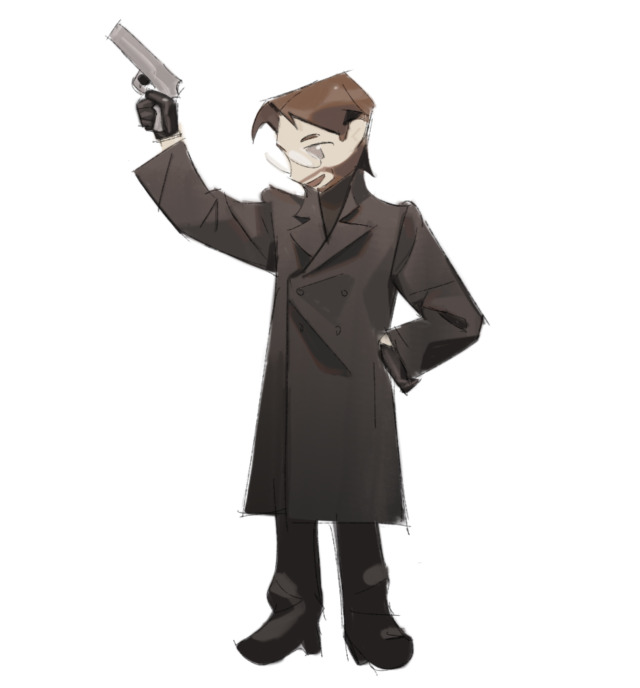
Roman Roman Roman!!

WIP for printing class !
First time drawing using Adobe Photoshop CC!!! We were tasked to come up with a description, moodboard, and sketch for a character, and I really enjoyed ;u;
I decided to just let my hand do whatever and…I love Hazbin Hotel and it really shows HDJHSDJ
Anyway ngl I really love this design,,,idk what to do with it but I’ll definitely use it as some point hh
Post link
The Chrysanthemum and the Sword’s place in Japanese scholarship about Japanese culture as described by Ryang is intriguing: she imputes that Benedict’s text has had so wide an effect on the Japanese perception of their own national character that it “helped give birth to Japan’s national culture” (“Chrysanthemum’s Strange Life”). This assertion is worthy of its own discussion, but for sake of argument I will take it for granted. Ryang attributes Benedict’s failure to discuss or examine Japanese imperial endeavour and their responsibilities to victims of these actions at least in part to the official historical narrative of postwar Japan—one that virtually erases any discussion of Japanese imperialism whatsoever. I find the assertion that Benedict is more or less singularly responsible for both the way that Japan frames its own modern history, and the western conception of Japanese culture, intuitively suspect, but further reading suggests that despite its manifold problems, it remains an influential and active nexus of discussion, both in and outside Japan: Ryang quotes Smith, who asserts that “there is a sense in which all of us have been writing footnotes to [it] ever since it appeared in 1946”. Prasol’s description of the tripartite cycle of Japanese imitation, adaptation and improvement of foreign ideas and technology (2) seems to support the dialectic around Benedict’s work, insofar as the decision to ignore or downplay imperial actions during World War II can be read as an adaptation and “improvement” of Benedict’s description of a “monolithic” . Ryang cites Nishi, a Japanese historian, who describes an American critique of Chrysanthemum which characterizes the Pacific War as imperials as “obsolete and laughable”. Ryang situates this revisionist historical narrative as arising more or less entirely from the influence of Benedict’s writing and as being codified by the ongoing relationship between Japan and the United States after World War II: “In the historical context of the U.S. military occupation of Japan, issues of Japan’s war responsibility and postwar reconstruction were reduced to a dialogue between Japan and the U.S. The rest — the Asian peoples Japan had colonized or subjugated — did not contribute(“Chrysanthemum’s Strange Life”).” The consistent thread I find in these texts is that of Japan-as-monolith, a singular entity with a massive inertia, as though it were not a nation of 126 million individual persons. Part of the point of Benedict’s writing, obviously, is to explain the interaction of self and society in Japan, but she tends to characterize “Japan”—and to some extent, America—as a homogeneous block. Perhaps this is more a critique of anthropological methodology on my part than of Benedict’s work particularly. A degree of generalization will be necessary in any wide-ranging examination of a group; it just seems that in the case of Chrysanthemum, especially with regard to the scholarship around and about it which has followed, the generalizations that Benedict adhered to ought to have been more thoroughly examined from the outset. Works Cited Benedict, Ruth. The Chrysanthemum and the Sword. Boston: Houghton Mifflin, 1967. Prasol, Alexander. Modern Japan: Origins of the Mind: Japanese Traditions and Approaches to Modern Life. Singapore: World Scientific, 2010. Ryang, Sonia. “Chrysanthemum’s Strange Life: Ruth Benedict in Postwar Japan.” JPRI Occasional Papers 32 (2004): accessed 9 September 2013. (This is not good text analysis and I am not terribly happy with it; I’ll do better with the subsequent ones. It is merely rough sketches of thoughts about the texts and really poorly organized. To my followers: feel free to ignore/Tumblr Saviour these posts, they’re for school. They’ll all be tagged “huco 617”.) Comment on this post and others you love.
Finally, comments on Tumblr posts! Learn how.
Posted by Daniel McKechnie.
I forgot to post this assignment from last year! It was a layout assignment in which we designed a set and a couple of storyboard shots for a script we were given by the instructor. These aren’t as bad as I remember them being, glad I rediscovered them when I was cleaning out my computer today.
Post link
Last layout assignment I worked on. I was surprisingly pretty happy with these (which admittedly is rare for me when it comes to layout)! I had to create a layout with a more realistic approach, and then the same thing with a more stylistic take.
Post link
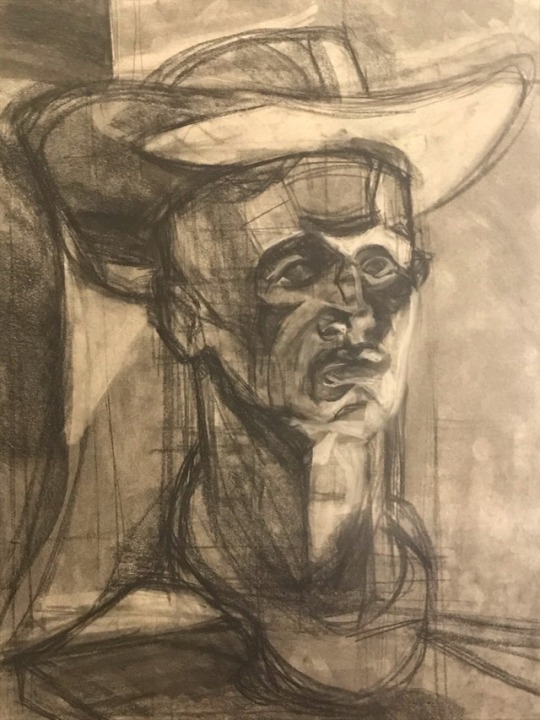

(A cowboy, baby)


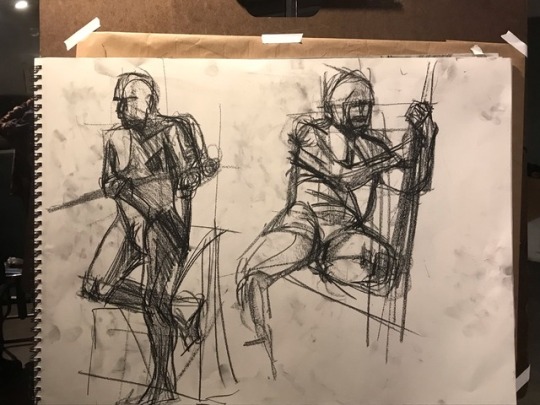
3-10 min gestures
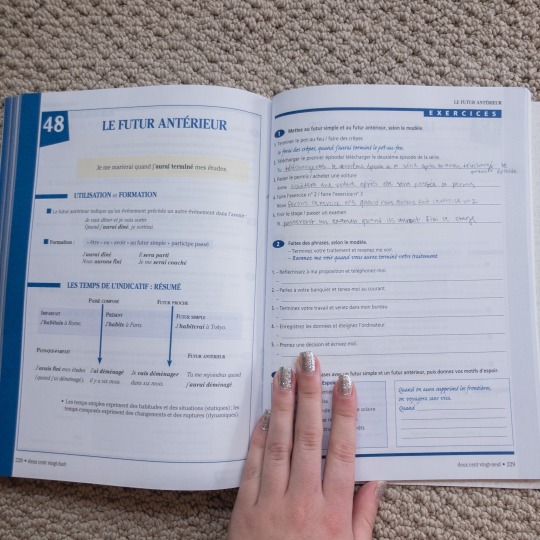
10/15/20
oh french 302….
xo- gg
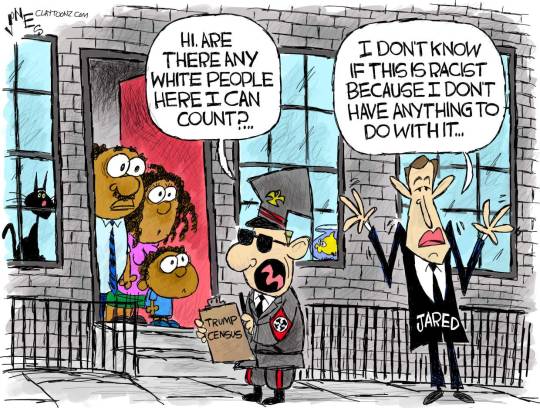
This is a cartoon by artist Clay Jones, who runs a blog for showcasing his cartoons called Tales from the Trumpster Fire. This piece specifically looks to target the racial targeting involved in the collection of censuses and Jared Kushner’s overseeing of the secret coronavirus task force. There aren’t a ton of symbols in here, but we can point both to the Nazi armband on the census taker and the SS insignia on his hat as a representation for the artist’s belief that these practices are racist and totalitarian and comparable to certain nazi practices. We also have the dress shirt and tie on the father, which is meant to symbolize that he is a hard working man. This is meant to emphasize the injustice of the family being ignored and looked over by the man looking to take census information from only white people. Things are labeled for clarity, such as the word Jared on Jared Kushner’s body. His head is already exaggeratedly long with the long outward ears and big lips for which he famously has. I believe the labeling of Kushner is to let people know who it is despite the fact they’ve already done a caricature of him, only because he isn’t yet a household name, so some folks might not recognize him on appearance alone. Here, there isn’t so much an analogy, as much as there is a heavy exaggeration of what is actually happening. Jared Kushner isn’t involved in actually going door to door and ignoring the censuses of black citizens, but that is what him and his organization are doing in a metaphorical sense. They’re not literally hollering out for only white voters to complete the census, it’s just that they’re ignoring and not putting the same sort of emphasis on collecting black votes. The cartoonist is saying that this is obviously a bad thing and thinks it resembles nazi-like fascist. Even though I agree, I don’t really find this piece that persuasive, as it is both very basic, and the view it argues against isn’t one I can see many people agreeing with in the first place. There aren’t a ton of people who believe censuses of white people are more important, because most average people would see that as a cartoonishly evil view to hold. However, I can imagine that some diehard Trump supporters who view immigrants as evil outsiders, and think white is the national race of America, would take issue with the comic. I definitely don’t think those people would be persuaded, though.

by artist Tornoe for The Inquirer
Symbols: Face mask, Phillies Jersey, Foam Finger. The face mask represents coronavirus prevention measures, the Phillies jersey and foam finger represent sports fandom.
Exaggeration: No noticeable exaggeration, other than there only being one fan in the empty stadium. Either the event wouldn’t allow an audience, or there would be more people at this event. Also it is exaggerated here that the man would have no problem going out in public to watch the sport, but he’s not willing to accept a hot dog from a worker who potentially has the virus.
Labeling: Very limited use of labeling here, besides the Hot Dog vessel, which would be labeled in real life, as well as the jersey.
Analogy: Not really any analogy here, it is more poking fun of the current situation by presenting us an absurd hypothetical scenario.
Irony: I think the irony here is that the fan is so devoted that he made his way out to the sporting event during quarantine and he’s so loyal to his team, but he’s still cautious about the guy serving hot dogs. I think it could also be joking about how unsanitary the hot dogs are known for being.
This cartoon is about the closing off of sporting events to audiences and the fans who are heartbroken by it. I don’t think the cartoonist feels any particular way about it, except for that it’s ridiculous how devoted sports fans are for their teams. I see this as a cartoon that’s more trying to find humor in a political situation than try to take down a specific figure or issue.

by artist Loujie for Cagle Cartoons
Symbols: Steak, Statue of Liberty, Coronavirus Cells, Fat guy, Torch, Tablet from the Statue.
The steak is a symbol of wealth, as well as the “fat cat” representing greed and wealth. The coronavirus cells represent the pandemic, and calamity affecting the people outside the window. The statue of liberty in this case representing America, as well as her torch representing freedom and democracy, and the tablet representing the Fourth of July and the declaration of independence, which the fat cat is eating his steak on. Red wine on the table also represents luxury.
Exaggerations: The fat guy is exaggerated in his rotundity and the poor people outside are exaggerated in their panic pounding at the window. The statue of liberty is also scaled down to be able to fit into the room, which is the opposite of exaggeration.
Labeling: The Rich, The Poor.
Analogy: America bailing out the rich and doing little for the poor is like our values bending over to serve the rich. They’re luxuriating while the average person is suffering.
Irony: The rich are comfortable and profiting more than others, while the poor are left to get sick and suffer below. It’s ironic because America wasn’t founded on those values, but Lady Liberty is bowing to the whims of the elite.
The artist is clearly saying it’s wrong that this is happening as the average Americans build the backbone of the country. He thinks income inequality is out of control and the wealthy are controlling America to benefit them. People who disagree with them would be rich people or the poor people who worship the rich and want to become part of that class. Not a very convincing piece, more just solidifies what people already know about the upper class.
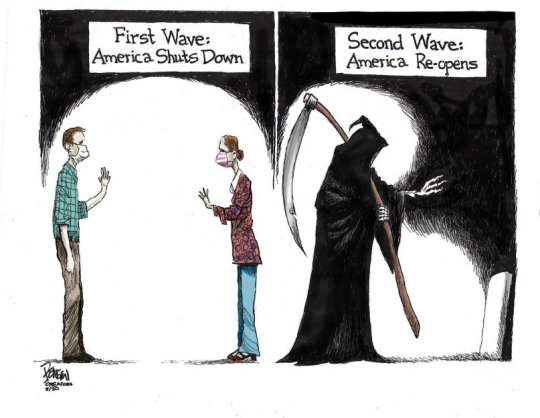
by artist Steve Benson for Creator’s Syndicate
Symbols: Death, Grave Stone, Covid Face Masks
Exaggerations: Not everyone is going to die so the right side is a bit of an exaggeration, but the death representing America reopening represents the massive casualties that can occur from reopening early amidst the second wave of covid-19.
Labeling: “First wave: America Shuts Down” “Second Wave: America Re-Opens
Analogy: Opening up businesses early is like inviting death into the country.
Irony: By trying to save our economy, we’d be killing our people, and thus doing devastating irreversible damage to the economy.
The artist is concerned about America Reopening early and believes we will suffer many casualties because of this. Opponents of this message would be conspiracy theorists, conservatives, and business owners afraid of losing profits or going out of business. I find it fairly convincing as political cartoons go, but I don’t think it’s really gonna sway anyone.
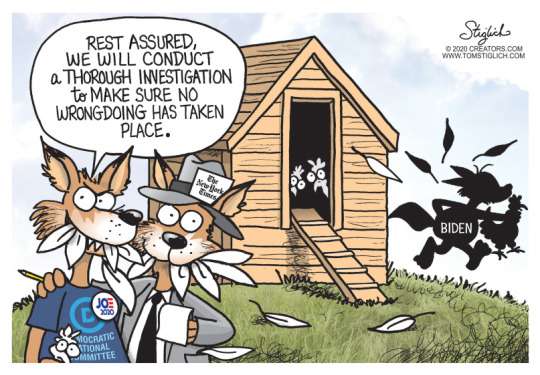
by artist Tom Stiglich for MediaNews Group
Symbols: Foxes, Feathers, Joe Biden Campaign Pin, Chickens, Chicken Coop.
Exaggerations: The New York Times, DMC, and Joe Biden have been anthropomorphized into foxes. Joe Biden is shown to be murdering chickens, which is not what he actually has done.
Labeling: New York Times, Democratic National Committee, Biden.
Analogy: The New York Times and DMC are in cahoots with Joe Biden aka fellow foxes, so them saying they’ll investigate him fairly, is like foxes saying they’ll investigate a chicken murder perpetrated by a fellow fox fairly.
Irony: They all committed the crime and are covering it up together.
This cartoonist is untrustworthy of Joe Biden and the people who claim to be investigating his claims of wrongdoing. People who disagree with this would be staunch liberals, or people who like Joe Biden. For me it is fairly persuasive, because even though I am a liberal, I am wary of trusting Joe Biden, or the New York Times, or the Democratic National Committee. I think it’s a cartoon that reaches both sides of the aisle because Joe Biden is a terrible candidate, and even us liberals who are voting for him are really not happy with him as an option. I do appreciate that during a time of corona-virus, this is one of the few up to date cartoons that chooses to tackle another topic, and I applaud it’s originality while still being timely.



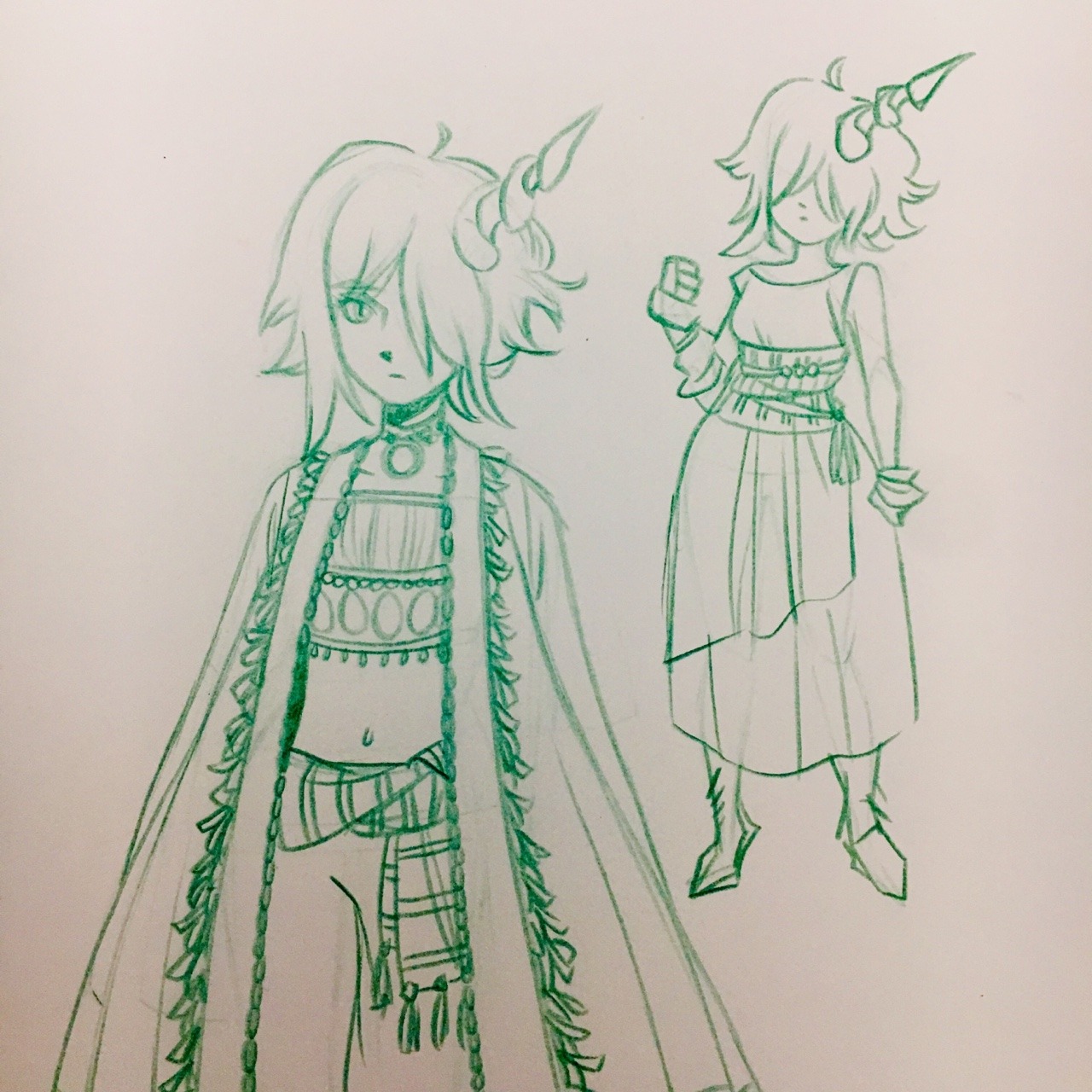
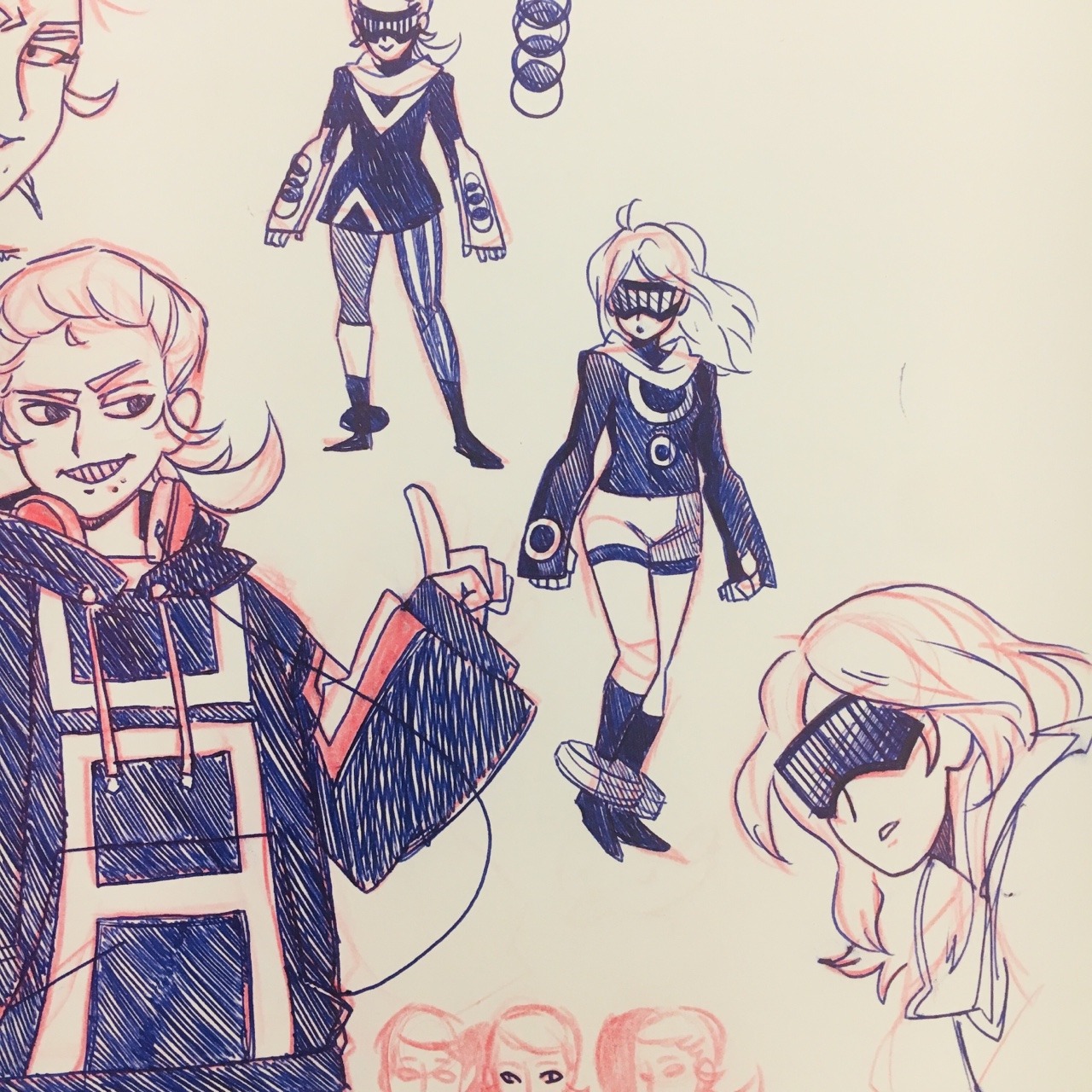




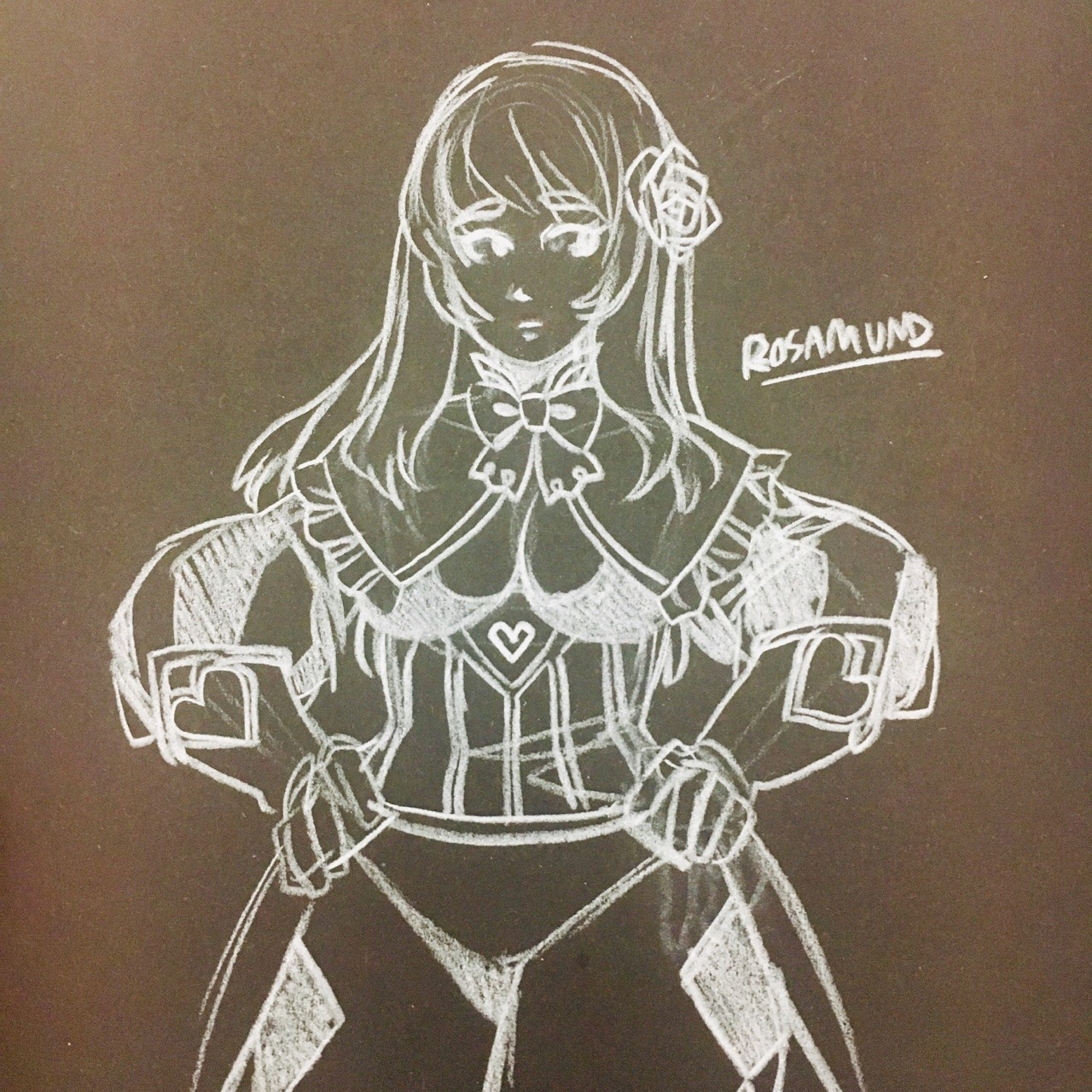
everything is doodles and nothing is finished!!!
well
some things are finished, but only because they’re due for class (the first and third ones are also school-related)
have the smattering of whatever i managed to draw in the time since i last posted. i heard about tumblr going dicks up, so i’m @rujellyroll on twitter if anyone wants to follow. i should say in advance that i don’t use it much, but i probably will, if tumblr ends up becoming a giant dumpster fire

i feel like y’all deserve to see what i turned in for a grade this semester
i got an a. my teacher also loves mbmbam
An anti smoking poster i had to make for school



